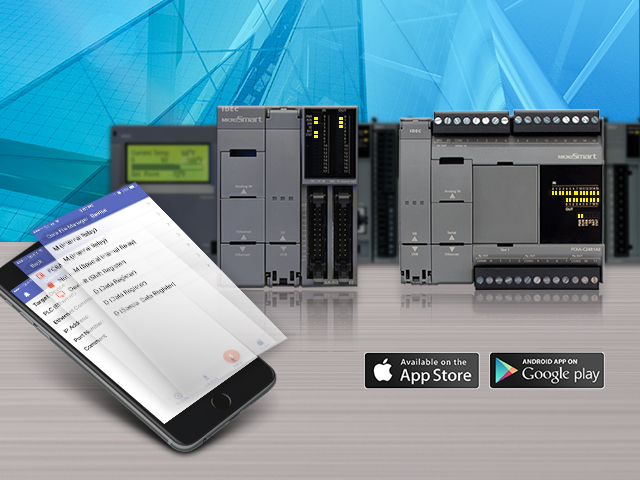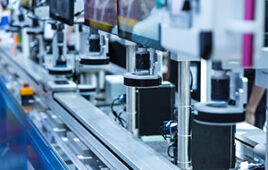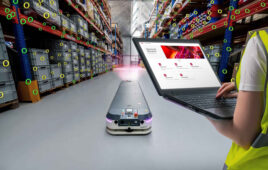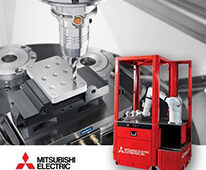Systems for integrating IoT devices and smart equipment can be architected in many ways, and end users will find easier access when mobile apps and FTP access are incorporated.
Don Pham, Senior Product Marketing Manager, and Linda Htay, Product Marketing Specialist, IDEC Corp.
Industrial and commercial users realize the growing availability of intelligent devices at their sites and are investigating ways to create value from the data these devices can provide. The first step is to ascertain device status and information, and to do so the data must be accessed and displayed. There are many ways to do this, some of which can involve significant hardware and software infrastructure.
End users are also familiar with personal mobile applications that let them easily and remotely check on their home thermostats, alarm systems and other smart consumer devices—so a natural thought is to look for similar apps usable with industrial smart devices. Fortunately, these types of apps are becoming more widespread in the industrial arena, providing an improved means of remote access in many applications.
An architecture for IoT success
Internet of things (IoT) devices can include something as simple as a single field sensor for detecting temperature, or more complex systems with many data points like a packaged water pumping skid. Even older hardwired devices can be incorporated through controller I/O to boost their effective intelligence. Regardless, end users are architecting their visualization and control infrastructures to take advantage of these IoT devices.
An IoT-ready infrastructure often includes integration of programmable logic controllers (PLCs) and human-machine interfaces (HMIs) installed in the field to provide the first-line connection to IoT devices. These local PLCs and HMIs can gather the data, scale it or perform other necessary pre-processing, concentrate or arrange it as needed and then make it readily available for higher level systems.
Data from the local PLCs and HMIs can be accessed by larger SCADA systems, or via web browsers if the PLCs and HMIs have built-in web server capability. However, many times end users want lightweight ways to remotely access information without building in excessive layers of computing. This is where the convenient accessibility delivered by mobile apps and file transfer protocol (FTP) functions can quickly and easily deliver just what users need.

IDEC PLCs and HMIs work with the WindEDIT Lite app to provide an easy way for users to connect, view, change and transfer data.
Gathering data at the source
Some IoT devices can reside directly on an Ethernet Wi-Fi network, whether this is an IT-based business network or an operations plant-floor network. While this makes it possible for higher level SCADA systems to directly connect with these intelligent network-enabled devices, that isn’t always the best approach for a variety of reasons ranging from cybersecurity concerns to network loading issues. Instead, it often makes sense to install a field-located controller closer to the IoT devices, and then configure it to be an IoT data concentrator.
For hardwired devices or those using industrial communication protocols like Modbus or BACnet, there is even more of a reason to install local PLCs or HMIs because these controllers use these connections natively and are the best way to bridge these signals to an IT network.
Some PLCs and HMIs have overlapping capabilities. Traditionally the key feature of a PLC has been wired inputs and outputs (I/O), and the prominent feature of an HMI has been visualization. Today, many modern PLCs include some local visualization, while some HMIs can control and monitor a limited amount of I/O. In addition, a growing area of overlap regards the networking and communication abilities of these devices. Both PLCs and HMIs can offer Ethernet networking, support many communication protocols and provide browser-based access by serving web pages.
Many sites already need PLCs to provide some level of direct control and HMIs to supply the corresponding visualization. Therefore, PLCs and HMIs may be in service and can perform additional duties by gathering IoT data. Or, if it is more convenient, the site can install more PLCs and HMIs dedicated to IoT and data concentration tasks.
Other data handling routes
With so many options for connecting IoT devices to controllers and HMIs, and in turn for users to access the data, it might seem that nothing else is needed. However, the cost and effort involved has not yet been addressed.
Large SCADA systems are expensive to license, deploy and configure. They can require extensive IT infrastructure and dedicated personnel for support. This level of effort can be warranted for large process projects or integrated systems, but it may not make sense for many sites.
For small- to medium-sized sites, the ability to use a browser to access a local controller is a convenient feature when available. Some PLCs and HMIs offer built-in browser-accessible displays to provide diagnostics and even some configuration. Taking things a step further, many HMIs can replicate and serve the local functionality to a remote browser, extending the capability of the HMI to wherever the user has a portable device.
A third scenario is possible if the local PLC or HMI can host and serve web pages. In this case, the user can develop the basic web pages for displaying the data of interest, and then use their browser of choice to access them. This type of connectivity avoids software licensing costs, but it does require users to be comfortable with creating web pages and configuring their network to make them accessible. Some manufacturers improve this process by including easy-to-configure web page development software with their systems.
The FTP option
For intermittent bulk transfers of one or more data files, there is a standard PC-based protocol called FTP. The FTP protocol has most commonly been used between client and server PCs on a network, providing a free and easy data transfer method with no software licensing costs.
However, FTP is also applicable for PLCs and HMIs compatible with protocol, and it is a powerful tool because it allows users to upload and download data files to their computing device as needed. A common application is when a local PLC is logging machine or IoT data into files. Users can rapidly transfer these data files from the PLC to the destination of their choice.
Although FTP is suitable in many cases, there is an even more convenient option for remotely accessing more limited amounts of data.
Apps are easier
Another avenue exists for remotely accessing PLC, HMI and therefore IoT data. This is when the PLC of HMI supplier offers a native mobile app for iOS or Android devices. A native app can deliver an improved user experience because much of the behind the scenes details are already handled. Users only need to install and run the app, connect their mobile device to the target controller and choose the data to monitor or adjust (Figure 1).
It is best if these industrial mobile apps are free or very low cost because end users will want to install them on many devices. Once installed, the first step is to gain connectivity. For users remote from the site, this access will commonly be via the internet.
A popular method of connectivity for local users is to use the site’s Wi-Fi connection, as long as the PLCs or HMIs are available on this network. Wi-Fi connectivity gives users the most freedom to roam about and observe plant operations in the real world and through the app.
However, it may be desirable to keep such access localized with functionality best implemented with Bluetooth wireless. A limited-range Bluetooth connection lets users take advantage of the mobile app just when they are physically near the PLC.
An advantage of both types of wireless technologies, and updateable apps, is that users never need to worry about having the proper cable in hand, opening a control panel or loading the right version of software or drivers.
Such easy accessibility raises questions around security, as it should. Apps for connecting to PLCs or HMIs must offer role-based security, configurable for each user with their own username and password. With these features, the administrator can control who accesses the PLCs or HMIs, and what data they can read or write.
Developing displays
Once a user has connected their device to the PLC or HMI and logged into the app with the proper credentials, the next step is to display the desired data. Whereas PLCs or HMIs with built in web servers would require users to develop graphics, that is not quite the case with an app.
An app facilitates navigation through data registers, inputs, outputs, timers, counters and other typically used values. These are selected not with programming, but through simple configuration using a built-in dialog interface (Figure 2). Other options allow users to pre-configure listings of just those points needed, or provide the capability to configure and view trend displays (Figure 3).

IDEC’s WindEDIT Lite app provides convenient menu-driven mobile access to PLCs and HMIs, allowing users to easily view IoT data.
This type of app would be most useful simply to monitor key data points. These could be machine operating speeds, temperatures from local IoT transmitters or other key data points. A more advanced application might let users adjust parameters or machine options. It is easy to see how a ready-made app facilitates remote viewing and changing of data, without requiring an extensive computing infrastructure to be installed and maintained.
So far, we have considered the viewing of live data or the trending of recent data. Another option used by many PLCs is to log data within the PLC or to an SD card. Not only should the app enable the user to view this type of historical data, it should allow users to email it to other users, or even push it to site- or cloud-based databases or data storage platforms.
An App in the toolbox
Apps provide easy access to PLC, HMI and IoT data, but once connected they can also be used by maintenance personnel to perform other extended operations. The most common way would be for a technician to view system inputs and outputs while troubleshooting a problem.

The WindEDIT Lite app even enables more advanced capabilities like data trending, uploading and downloading of data files, and updating system firmware.
More advanced capabilities free the tech to do their work anywhere in wireless range. They can also be used to update firmware, and to upload or download program configurations. A mobile app becomes another tool in the technician’s toolbox, much easier to cart around than a laptop and not requiring any special cables.
Many end users know they have IoT devices available at their sites and want to find the simplest and most effective method to access device data. These sites are often familiar with PLCs and HMIs but they don’t have the resources to create and maintain a large computing installation. Just as mobile apps are a quick and convenient way to access consumer devices at home, the right apps combined with PLCs and HMIs can enable end users to easily access their IoT devices and smart equipment.
IDEC Corp.
us.idec.com
Filed Under: Factory automation, IoT • IIoT • Internet of things • Industry 4.0, Cybersecurity




